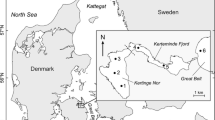Summary
Juvenile Antarctic krill (Euphausia superba) were fed the diatom Phaeodactylum tricornutum at concentrations ranging from 0.0–5.0 mgCl-1. Intermoult period (IP) decreased, but an increment of body length per moult (ΔBL) of juvenile krill increased, up to a concentration of 1.0 mgCl-1. No further effect of food concentrations on IP or ΔBL was seen at concentration beyond 1.0 mgCl-1. IP plateaued at 23.8 days and ΔBL, 1.14 mm. The maximum daily growth rate (ΔBL/IP) of juvenile krill was calculated to be 0.047 mm day-1. ΔBL and IP were correlated and the relationship is expressed as ΔBL=-0.0066IP+2.47 (r=0.58, n=141, P<0.01). Growth conditions of krill in the Southern Ocean are discussed in terms of available food concentration in there.
Similar content being viewed by others
References
Astheimer H, Krause H, Rakusa-Suszczewski S (1985) Modeling individual growth of the Antarctic krill Euphausia superba Dana. Polar Biol 4:65–73
Bargmann HE (1945) The development and life history of adolescent and adult krill Euphausia superba. Discovery Rep 23:103–176
Boyd CM, Heyraud M, Boyd CN (1984) Feeding of Antarctic krill Euphausia superba. J Crust Biol (spec no) 1:123–141
Buchholz F (1983) Moulting and moult physiology in krill. In: Schnack SB (ed). On the biology of Euphausia superba. Proc Seminar Rep of the Krill Ecology Group. Bremerhaven (FRG) pp 81–88
El-Sayed SZ, Mandelli EF (1965) Primary production and standing crop of phytoplankton in the Weddell Sea and Drake Passage. In: Llano GA (ed) Biology of the antarctic seas, vol II. Am Geophys Union, Washington DC, pp 87–106
El-Sayed SZ, Weber LH (1982) Spatial and temporal variations in phytoplankton biomass and primary productivity in the south-west Atlantic and Scotia Sea. Polar Biol 1:83–90
Fraser FC (1936) On the development and distribution of the young Euphausia superba. Discovery Rep 14:1–192
Fukuchi M (1980) Phytoplankton chlorophyll stocks in the Antarctic ocean. J Oceanogr Soc Jpn 36:73–84
Guillard RRL, Ryther JH (1962) Studies of marine planktonic diatoms. I. Cyclotella nana Hustedt and Detonula confervacea (Cleve) Gran. Can J Microbiol 8:229–239
Hartnoll RG (1982) Growth. In: Abele LG (ed) The biology of Crustacea, vol 2. Academic Press, New York London, pp 111–196
Holm-Hansen O, Huntley M (1984) Feeding requirements of krill in relation to food sources. J Crust Biol (spec no) 1:156–173
Ikeda T (1985) Life history of Antarctic krill Euphausia superba: a new look from an experimental approach. Bull Mar Sci 37:599–608
Ikeda T, Dixon P (1982) Observations on moulting in Antarctic krill (Euphausia superba Dana). Aust J Mar Freshwater Res 33:71–76
Ikeda T, Dixon P, Kirkwood J (1985) Laboratory observations of moulting, growth and maturation in Antarctic krill (Euphausia superba Dana). Polar Biol 4:1–8
Ivanov BG (1970) On the biology of the Antarctic krill Euphausia superba Dana. Mar Biol 7:340
Kosaki S, Takahashi M, Yamaguchi Y, Aruga Y (1985) Size characteristics of chlorophyll particles in the Southern Ocean. Trans Tokyo Univ Fish 6:85–97
Knox GA (1970) Antarctic marine ecosystems. In: Holgate MW (ed) Antarctic ecology, vol 1. Academic Press, London New York, pp 69–96
Mackintosh NA (1967) Maintenance of living Euphausia superba and frequency of moults. Nor Hvalfangst-Tid 56:97–102
Mackintosh NA (1972) Life cycle of Antarctic krill in relation to ice and water conditions. Discovery Rep 36:1–94
Mauchline J (1980) The biology of mysids and euphausiids. Adv Mar Biol 18:373–595
McClatchie S, Boyd CM (1983) Morphological study of sieve efficiencies and mandibular surfaces in the Antarctic krill, Euphausia superba. Can J Fish Aquat Sci 40:955–967
Murano M, Segawa S, Kato M (1979) Molt and growth of the Antarctic krill in laboratory. Trans Tokyo Univ Fish 3:99–106
Nemoto T, Harrison G (1981) High latitude ecosystems. In: Longhurst AR (ed) Analysis of marine ecosystems. Academic Press, London New York, pp 95–126
Paffenhöfer GA, Harris RP (1979) Laboratory culture of marine holozooplankton and its contribution to studies of marine food webs. Adv Mar Biol 16:211–308
Poleck TP, Denys CJ (1982) Effect of temperature on the molting, growth and maturation of the Antarctic krill Euphausia superba (Crustacea: Euphausiacea) under laboratory conditions. Mar Biol 70:255–265
Quetin LB, Ross RM (1985) Feeding by Antarctic krill, Euphausia superba: Does size matter? In: Siegfried WR, Condy PR, Laws RM (ed) Antartic nutrient cycles and food webs. Springer Berlin Heidelberg, pp 372–377
Rosenberg AA, Beddington JR, Basson M (1986) Growth and longevity of krill during the first decade of pelagic whaling. Nature 324:152–153
Ruud JT (1932) On the biology of Euphausiidae. Halvrad Skr 2:1–105
Segawa S, Kato M, Murano M (1983) Growth, moult and filtering rate of krill in laboratory conditions. Proc Natl Polar Res (spec issue) 27:93–103
Siegel V (1986) Untersuchungen zur Biologie des antarktischen Krill, Euphausia superba, im Bereich der Bransfield Strasse und angrenzender Gebiete. Mitt Inst Seefisch, Hamburg 38:1–244
Snedecor GW, Cochran WG (1967) Statistical methods. Iowa State Univ Press, Ames, Iowa, pp 1–593
Yamaguchi Y, Shibata Y (1982) Standing stock and distribution of phytoplankton chlorophyll in the Southern Ocean south of Australia. Trans Tokyo Univ Fish 5:111–128
Author information
Authors and Affiliations
Rights and permissions
About this article
Cite this article
Ikeda, T., Thomas, P.G. Moulting interval and growth of juvenile Antarctic krill (Euphausia superba) fed different concentrations of the diatom Phaeodactylum tricornutum in the laboratory. Polar Biol 7, 339–343 (1987). https://doi.org/10.1007/BF00293224
Received:
Accepted:
Issue Date:
DOI: https://doi.org/10.1007/BF00293224




